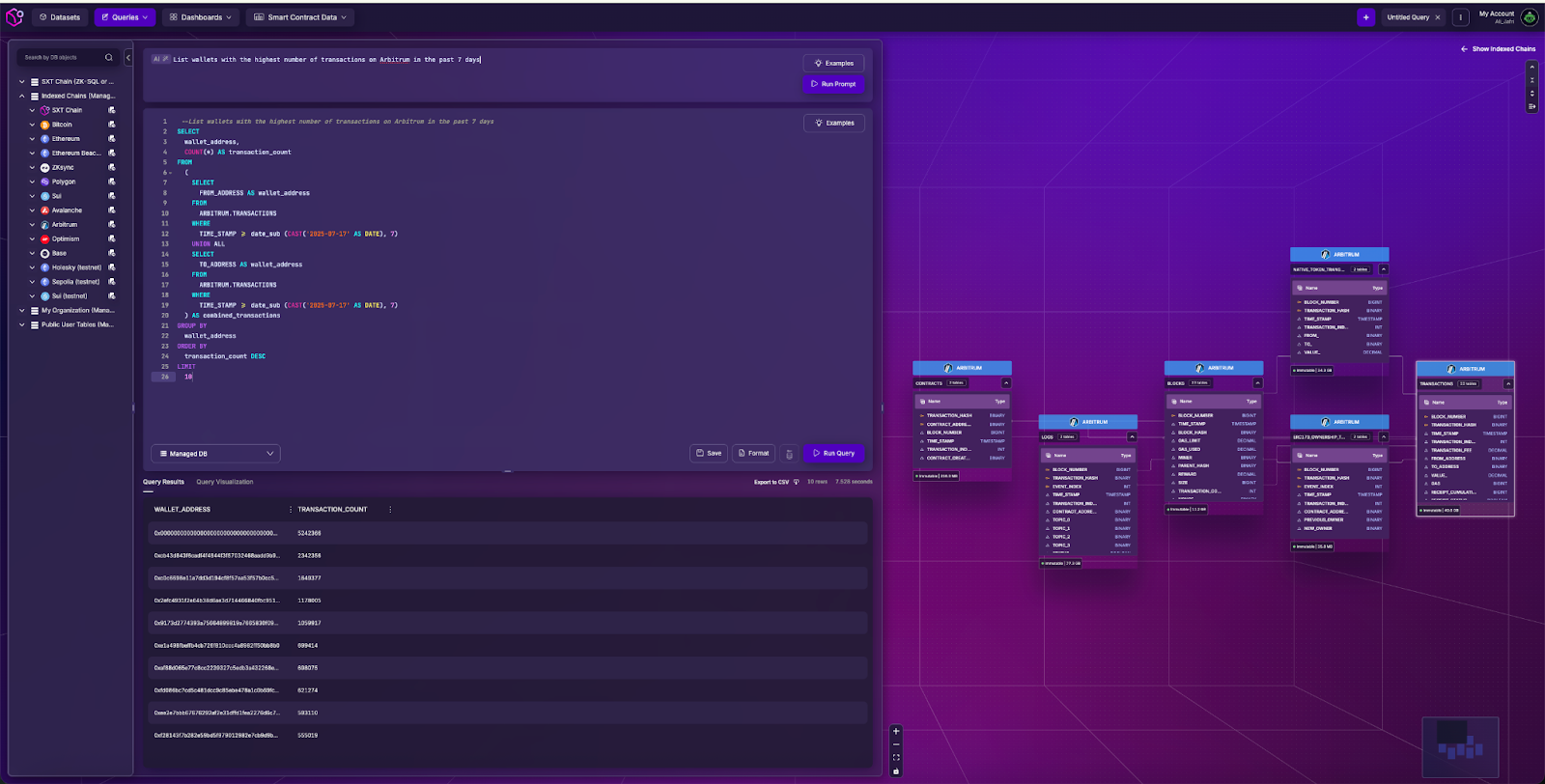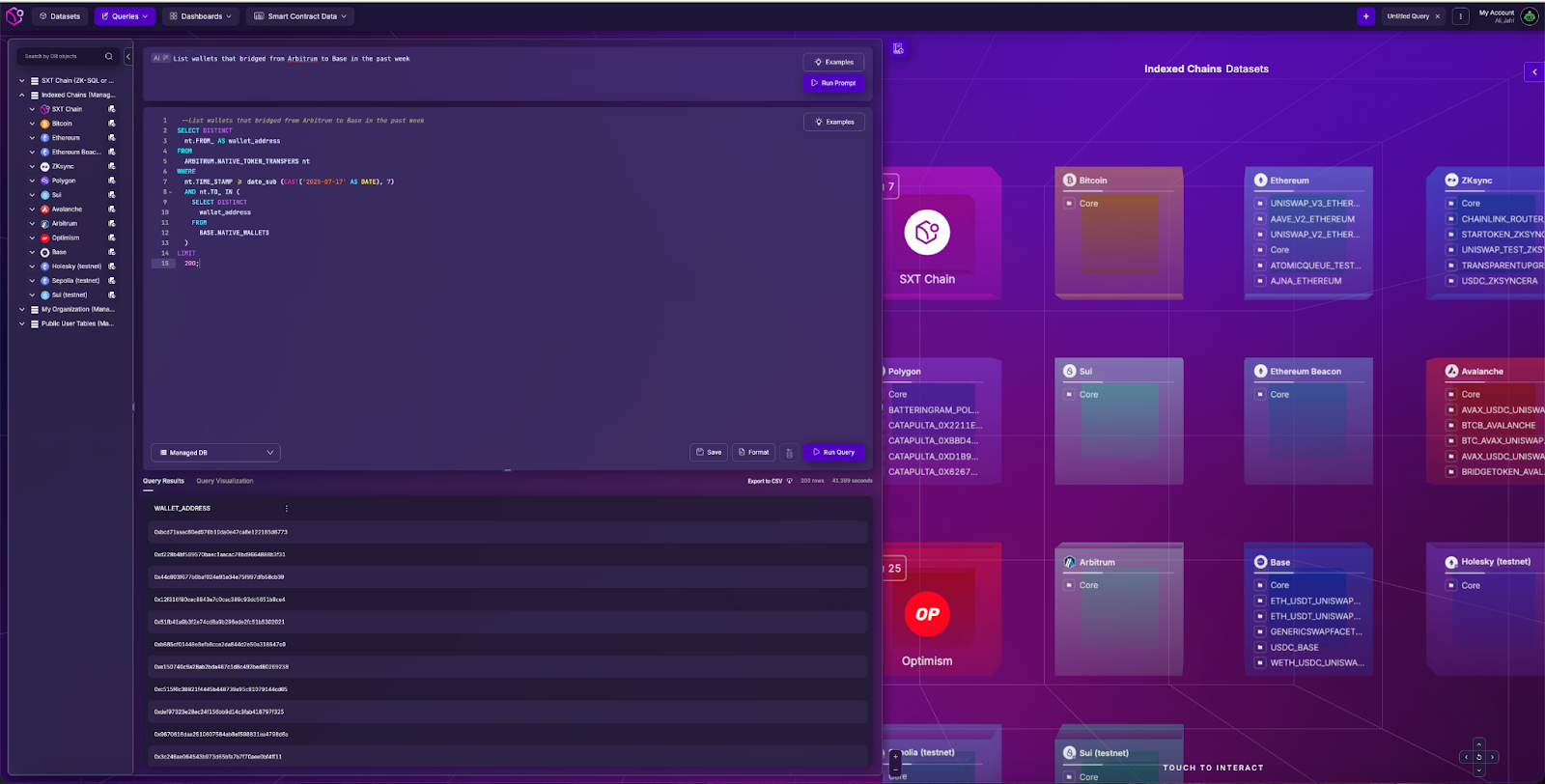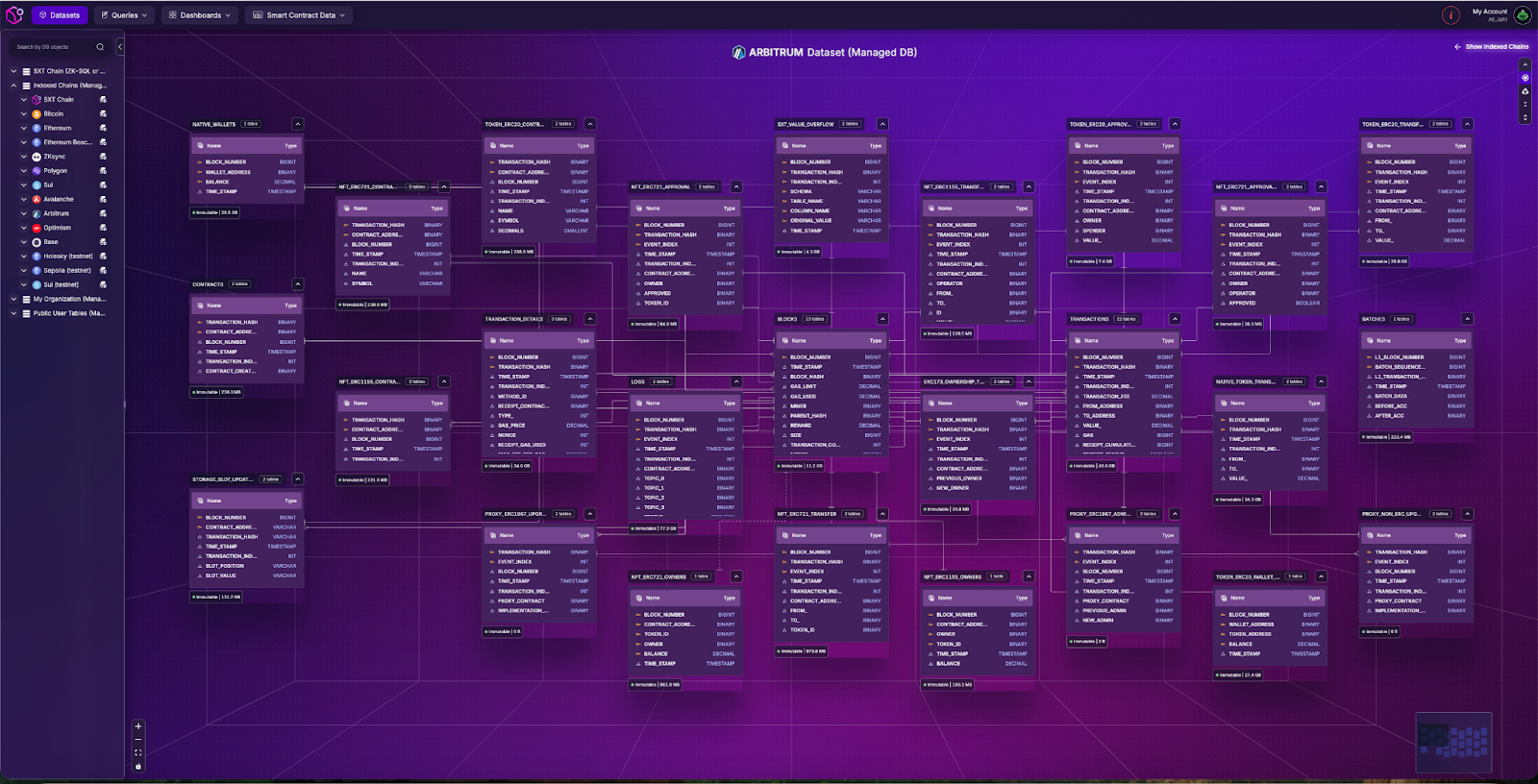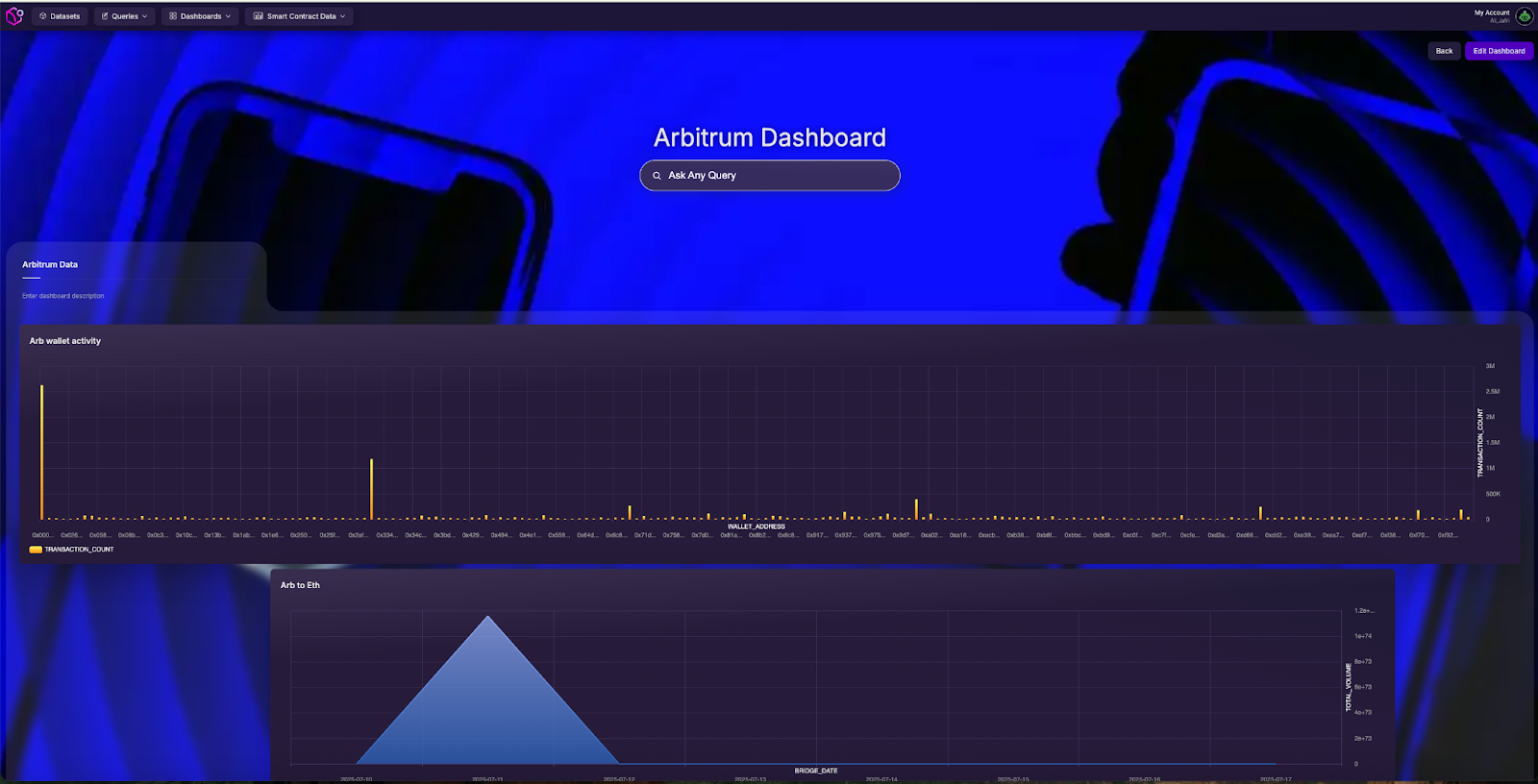Explore and Index Arbitrum Data Using Space and Time

Discover how to use Space and Time to explore and analyze data from the Arbitrum network. This blog walks through SXT Studio’s powerful features for accessing indexed Arbitrum data, including wallet activity, smart contract interactions, bridge flows, and real-time analytics. Whether you're building on Arbitrum or diving into its ecosystem for insights, this guide will show you how to tap into the data that powers it.
An Intro to the Arbitrum Network
Arbitrum is a Layer 2 network designed to scale Ethereum with faster transactions and lower fees. It brings improved performance to the Ethereum ecosystem without compromising on security or compatibility.
ETH on Arbitrum is used for gas and native payments across the network. Popular stablecoins like Arbitrum USDC are actively used in DeFi applications and wallet transfers. As adoption grows, more users are interacting with the Arbitrum network through Arbitrum wallets and dapps.
Space and Time allows you to explore and analyze Arbitrum data using natural language or SQL. You can track wallet activity, view token transfers, and monitor onchain behavior across the network.
In this guide, we’ll walk through how to access indexed Arbitrum data using Space and Time, from wallet queries to bridge flows and smart contract analytics.
The Arbitrum Architecture
Arbitrum is built on optimistic rollup technology, allowing it to scale Ethereum by batching transactions and posting proofs back to the main chain. It is fully EVM-compatible, so developers can deploy Ethereum-native contracts without changes.
The network supports standard tools like Arbitrum RPC endpoints and Arbitrum explorers, but these often offer limited customization and query flexibility. Platforms like Arbitrum Scan or a typical Arbitrum block explorer allow basic lookups but fall short when it comes to deep, cross-contract analytics or historical tracing.
With Space and Time, you get a flexible Arbitrum blockchain explorer powered by SQL and natural language. You can go beyond surface-level metrics and build complex queries to analyze wallets, contracts, token flows, and network activity over time.
Scan Indexed Arbitrum Data, Arbitrum Wallets, and Bridging Activity with SXT
With Space and Time, you can easily query the Arbitrum network using natural language. The platform automatically translates your input into SQL, allowing developers, analysts, and non-technical users to explore indexed Arbitrum data without writing any code.
Track Arbitrum Wallet and Contract Activity
To start tracking arbitrum wallets and contract interactions, follow these simple steps:
- Log into the Studio
- Navigate to the “Query Editor” under the “Queries” tab
Examples of what you can ask:
- List wallets with the highest number of transactions on Arbitrum in the past 7 days
- List Arbitrum wallets with the most USDC transfers in the last 24 hours
This makes it easier to investigate wallet trends and contract usage without needing to connect to an Arbitrum RPC or rely on static explorers.

Analyze Arbitrum Bridge Activity
Space and Time also supports real-time querying of cross-chain bridge data. To monitor bridging flows:
- Log into the Studio
- Navigate to the “Query Editor” under the “Queries” tab
Example queries:
- Show the total daily volume of assets bridged from Arbitrum to Ethereum over the past 7 days
- List wallets that bridged from Arbitrum to Base in the past week
Whether you are researching cross-chain trends or monitoring bridge usage for DeFi protocols, these queries give you deep insight into how funds move across the Arbitrum ecosystem.

Visualize Arbitrum Data in Real Time
It is extremely easy to get a visual representation of the indexed Arbitrum data and transactions using the SXT Studio. Just follow the simple steps below:
- Click on the “Datasets” option in the main menu
- Click on “Arbitrum” Data

Once you've written a query inside Space and Time Studio, you can instantly turn the results into live visualizations. This is especially useful for tracking Arbitrum wallet activity, smart contract usage, or bridge flows in real time.
To create a dashboard:
- Log into SXT Studio
- Navigate to the “Dashboards” tab
- Click “New Dashboard” and choose from templates or start from scratch
- Add a chart, paste your query, and choose how to visualize the data (bar chart, line chart, table, etc.)
These dashboards make it easy to monitor key trends on the Arbitrum network. Whether you're building a reporting tool, monitoring Arbitrum contract usage, or keeping an eye on bridge activity, Space and Time gives you one of the best tools to monitor Arbitrum network activity with indexed Arbitrum data.
We’ll use the previously mentioned queries as an example

Build Your Own Arbitrum Blockchain Explorer
If you're looking for more flexibility than what Arbitrum Scan or other block explorers provide, Space and Time lets you build your own custom Arbitrum blockchain explorer. You can combine wallet activity, smart contract calls, bridge flows, and token transfers into a single interactive dashboard.
With the queries you’ve already written, it’s easy to create live dashboards that help you track onchain activity, monitor protocol usage, and follow asset movement across the Arbitrum network.
Here are some examples of what your explorer might include:
- Daily volume of the Arbitrum to ETH bridge
- Most active smart contracts based on unique interactions
- Wallets that recently bridged assets from Arbitrum to Base
Whether you're running analytics for your team or replacing a static tool like Arbitrum Scan, Space and Time gives you everything you need to monitor Arbitrum data in real time. Start querying the Arbitrum blockchain today for free in SXT Studio.
Start querying Arbitrum blockchain data for free
Scan and Index Arbitrum Data with Space and Time
Access to indexed Arbitrum data is key to understanding how the network is evolving. Developers, analysts, and teams need clear insight into wallet activity, smart contract performance, and bridging patterns across the ecosystem. Space and Time makes it possible to scan the Arbitrum network, run powerful queries, and visualize results in real time.
SXT Studio brings together all the tools needed to explore the Arbitrum blockchain at scale. From querying contract data to monitoring cross-chain activity, every part of the platform is designed to simplify onchain analytics. The result is a faster path to insights and more flexible ways to work with Arbitrum data.

